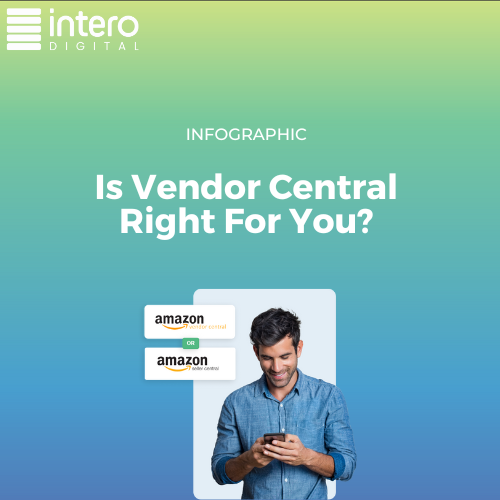
Is Amazon Vendor Central Right For Your Business?
Is Amazon Vendor Central Right For Your Business?
As Amazon increasingly becomes one of the world’s most potent online retail marketplaces, it offers independent sellers numerous opportunities to scale up their businesses. E-commerce companies that choose to utilize Amazon’s vendor services will find themselves with access to a whole host of powerful tools and resources. While it can feel overwhelming to begin incorporating Amazon into your existing sales structure and techniques, the benefits outweigh any growing pains.

UNDERSTANDING YOUR OPTIONS: VENDOR CENTRAL VS. SELLER CENTRAL
Amazon offers two primary selling options: Seller Central and Vendor Central. Seller Central is suitable for those who want to handle the entire process themselves, making it ideal for startups.
If you choose this third party option, you’ll be an independent seller selling directly to Amazon’s customers through the Seller Central system. You’ll manage your own inventory levels, add new products, and provide customer service through Seller Central.
In contrast, Vendor Central is best for established brands looking to sell their products in bulk to Amazon, which then manages the process of selling, shipping, and determining profit margins. You’ll need an invitation to join the Vendor Central program, and invitations are usually extended to sellers with high sales volume.
If you opt in to partnering with Vendor Central, you’ll be classified as a “First Party” seller, selling your products wholesale to Amazon. Your products will be listed as “Sold and Fulfilled by Amazon,” and Amazon will place purchase orders with your company. Your account will be managed via the Vendor Central platform.
Note that partnering with Vendor Central doesn’t eliminate the need to manage your own Amazon advertising, or product listings. Stock inventory does require less work to manage when partnering with Vendor Central, but you still must allow adequate time and funding to send from a local warehouse to Vendor or Seller Fulfillment by Amazon (FBA). Depending on your needs and opportunities, you can choose which platform to use on Amazon.
VENDOR CENTRAL:
Advantages:
- Suitable for very large brands and manufacturers who don’t want to manage direct consumer sales
- You just have to manage purchase orders submitted by Amazon while Amazon handles the rest
- Ideal for brands selling heavy or large products that have high fulfillment costs or products with very low price points that would be unprofitable to sell using FBA
Disadvantages:
- May offer less profit margin depending on the dimensions and selling price of your product
- Amazon may price match excessively, violating MAP and potentially upsetting other retail customers
- Amazon decides the quantity of items purchased, which may not reflect consumer demand, and can chargeback overstocked inventory
FULFILLED BY AMAZON (FBA) OR SELLER CENTRAL:
Advantages:
- Sellers have direct control over pricing, inventory, branding, management, and promotion of their products
- You can take a larger cut of the profit margin than Vendor Central sellers
- More direct interaction with customers
Disadvantages:
- Choosing to sell FBA can lessen the level of customer service as Amazon manages most inquiries around returns, exchanges, etc.
- Amazon may price match excessively, violating MAP and potentially upsetting other retail customers
WHAT KIND OF SELLER ARE YOU?
Overall, the decision between Vendor and Seller Central depends on a variety of factors, including the what type of seller you are, the type of products you’re selling, and your desired level of control over pricing, inventory, and branding. The following are examples of business and product best practices you can use to help guide your decision.
Established Brands: If you’re an established brand with a large customer base and established distribution channels, Vendor Central may make the most sense for you. This is because you can maintain their existing relationships with retailers and distributors, while also having a presence on Amazon without having to manage direct consumer sales. Vendor Central allows you to outsource the management of your Amazon sales to Amazon itself.
Small and Medium-Sized Businesses: As a small or medium-sized businesses that is just starting out, you may find that Seller Central is the better option. Seller Central is easier to set up and provides more control over pricing, inventory, and branding. You may also benefit from the ability to interact more directly with customers and manage your own customer service.
High-Margin Products: If your business has products that have a high margin, you may be better off choosing Seller Central. This is because you can take a larger cut of the profit margin compared to Vendor Central, where margins may be lower.
Heavy or Bulky Products: If you have heavy or bulky products, you may be better off choosing Vendor Central. This is because the cost of fulfillment for such products can be high, making it unprofitable to use FBA. With Vendor Central, Amazon manages your inventory and shipping, which can help reduce fulfillment costs.
WHAT ARE YOUR RESPONSIBILITIES ON EITHER PLATFORM?
Once you sign up for either Amazon Vendor Central or Seller Central, you will have specific responsibilities to fulfill. As a paid and exclusive membership platform, Amazon Vendor Central offers many benefits to its users, and your main responsibility would be to manage purchasing orders, billing, and avoid chargebacks.
On the other hand, if you choose to use Amazon Seller Central, you will be responsible for managing your own inventory, including any lost or damaged products, as well as handling taxation liabilities and sales reconciliation. Additionally, Amazon may block your account if they find that you are unable to maintain your stock levels, and charge you accordingly. While the rules regarding stocking are quite rigid for Amazon, a single person can handle a Seller Central account.
SELLER CENTRAL VS. VENDOR CENTRAL PROS AND CONS
If you’re unsure which service is right for you, consider the following pros and cons. Whichever system you choose, both are powerful e-commerce options that can optimize your business and increase sales.
| Vendor Central | Seller Central |
|---|---|
| Platform Stats | |
| Acting as a 1st party retailer hub | Seller is a 3rd party retailer |
| On an Invite only basis. This exclusivity creates legitimacy for sellers and can increase revenue | Uses a subscription-based model |
| Full access to Amazon Retail Analytics (ARA) | Access Analytics (Professional only) |
| Marketing | |
| Adding content is a time-intensive task | Easy to optimize product listings quickly and at any time |
| Time Investment | |
| Amazon takes care of customer service and related operations | Seller is more directly involved in customer service and related services |
| New products or product listings take several days to review | Sellers can start selling almost immediately |
| Selling Fees | |
| Sell products to Amazon at wholesale | 15% referral fee on product selling price and fulfillment fees |
| Getting Paid | |
| Payment with purchase orders rather than individual orders | Payment within two weeks of sale |
| Seller Control | |
| Contract negotiation with Amazon | Lack of flexibility in contract negotiation with Amazon |
| Lack of pricing control with a more extensive process when updating listings, Amazon exerts control over inventory | Full control over pricing, customer service, inventory, and shipping processes |
| Takes time for Amazon to update and review product information and pricing | Can begin selling immediately |
Increase your Sales Volume with
Amazon Vendor Central
As an ROI industry leader, Intero Digital has years of experience assisting sellers in achieving their revenue goals. With Intero Digital, our Amazon Vendor Central experts can streamline the Amazon Vendor process, help get you started, and ensure that your company is primed to engage with all the Amazon Vendor Central features.
Contact Intero Digital today to learn more about becoming a successful Amazon vendor.


